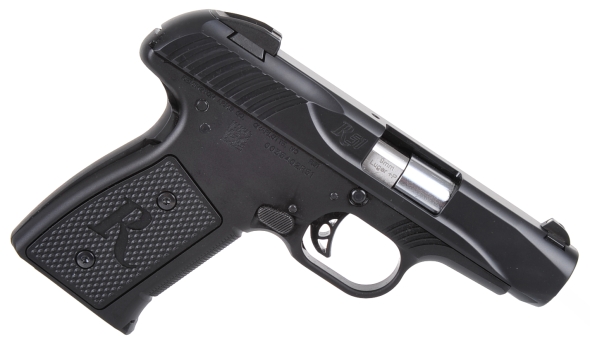
|
Handgun |
|
| Company | Remington |
| Point of Manufacturer | Charlotte, NC |
| SKU# | 96430 |
| Type of Action | SA Delayed Blowback |
| Caliber | 9mm Luger |
| Capacity | 7+1 |
| Barrel Length | 3.4″ |
| Barrel Material | 416 Stainless Steel |
| Verified Rifling Twist Rate | 1:10″ |
| Slide Material | Stainless Steel |
| Slide Finish | FNC |
| Frame Material | 7075 |
| Frame Finish | Matte Black Anodized |
| Grips | Poly – Removable |
| Front Sight | Dovetailed – Single Dot |
| Rear Sight | Dovetailed – Two dot |
| Weight of Firearm – Actual | 22.6 Oz |
| Trigger Pull – Actual | 7 Lbs 3 Oz. |
| Overall Length | 6.68″ |
| Overall Height | 4.63″ |
| Width | 1.08″ |
| Thumb Safety | No |
| Magazine Disconnect | No |
| Chamber View Port | Yes |
| Key Lock | No |
| CA Approved | No |
| MA Approved | No |
| MSRP | $448 |
|
All measurements are nominal unless marked “actual” |
|
The R51 is described by Remington as a fixed barrel, delayed blowback, single action autoloading pistol. Subcompact in size, it is chambered for the 9mm Luger round, +P ammo approved. The Model R51 is based on a J.D. Pedersen design, Patent No. 1,348,733, application filed on July 30, 1915 and awarded August 3, 1920. The design became the original Remington Model 51 that went into production in 1918 and out of the Remington catalog in 1927 chambered for the 32 Auto and 380 Auto cartridges. A 45 Auto version Model 53 was produced as a military trials prototype, but it never saw production.
The R51 is not a Browning 1911 design and not one of the many variations of striker designs. This is important to keep in mind when examining the pistol as its function and norms are different from the others noted. The R51 is Pedersen’s hybrid. It combines blow back and locked breech features where the pistol discharges, drives a breech block into a locked position against a stop shoulder in the frame, until the slide cam releases the breech block and cycles as bore pressure drops to zero.
The Petersen design provides practical advantages as it moves the recoil spring from a traditional guide rod position below the barrel, to around the barrel, which allows the bore centerline to be moved down closer to the shooter’s hand. This change provides increased control with recoil coming almost straight back to the hand and reduces the barrels leverage and ability to create muzzle rise. In the case of the new R51, Remington took this one step further by undercutting the trigger guard, which brings the shooting hand even closer to bore centerline and positions the trigger finger in a straight line to the trigger. The increased duration of a locked breech, not lock time, improves overall ballistic performance.
Between the ill fated 2014 launch of the Remington Model R15 and the current relaunch, the design was revised and enhanced in numerous ways. A very stand up response to what I will politely call “customer feedback”. Enhanced features include a precision-built fast-reset polymer trigger, an improved extractor design, a refined spring and many other finesse features that greatly improved the R51’s reliability. Remington deserves a good deal of respect for sticking with the product and ultimately making good on their commitments. The two year redesign was overseen by Michael Snyder, a Remington research engineer, whose background is roller coaster design for Disney, and incredibly challenging and complex applied physics environment.
Some personal observations
The R51’s art deco styling makes for a streamline firearm with virtually no sharp edges and corners. This makes the pistol easy to conceal and offers no purchase to grab onto clothing or a holster. The 20º grip angle and thin, but hand-filling frame, gives the R51 a very natural feel. What does that mean? In hand, the R51 fits like it belongs there and it becomes an extension of the hand when pointed.
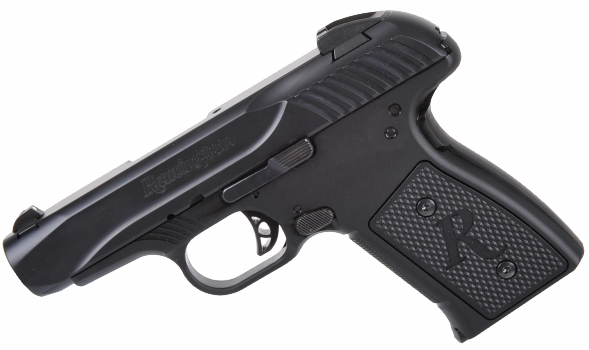
The smooth, full length contoured grip safety, 25 LPI front strap checkering, the slightly scalloped surface along the side of the frame are all engineered to conform to the hand. The slide stop and ambidextrous magazine release are well positioned for one hand operation and the contour of the grip safety requires no “speed bump” to assure actuation when properly grasped.

At 1″ and a smidgeon, the R51 is narrow and will lay flat under clothing. The sights are good for the application; a little wider U notch (0.178″), a little wider front blade than typical on subcompact 9mm pistols (0.175″), make target acquisition a quick proposition. The rear sight is the ultimate in no snag profiles. The small port on the top permits chamber checking for a loaded round without having to pull the slide back, although the manual suggests limited use of this feature.
Below: aluminum frame, stainless slide, breechblock, barrel, magazine, action spring bushing, and action spring… and I will bet you can tell which is which without number assignments or labels.
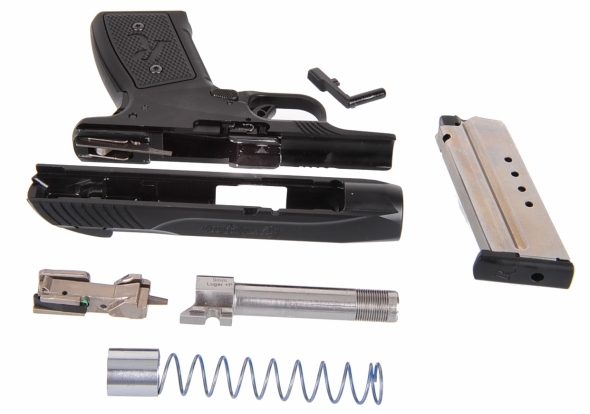
Takedown is… different and perhaps a bit awkward. That said, the disassembly process becomes routine after a few cycles. No, it is not as easy as disassembling as most tilting barrel designs, but not by much. A disassembly video on the Remington web site is nicely done. The manual illustrations are of relatively low quality, making it difficult to see the referenced detail in images. I’m sure Remington could easily improve this minor annoyance.
The Remington Model R51 without reading the gossip…

We passed on reviewing the R51 when it was initially introduced in 2014. There was a colossal group grope going, with everyone from firearm magazine editors to janitors offering their two cents or mimicking the caustic words of another without even seeing the firearm. The indication that at least some of the problems were real was substantiated by Remington’s withdrawal of the R51 from production, with the assurance that customers that they would eventually receive the firearm they thought they had purchased.
Customers were given the choices of receiving a Model 1911 R1, Remington’s 1911 design pistol, or getting a refund on their purchase or they could wait for the reintroduction of the R51. Half took the R1, a quarter took the refund and the remaining quarter waited for this new generation R51. That was a pretty comprehensive offer and, at 75%, an impressive stick with Remington in one form or another constituency. Not being a participant in any of the above, I received the subject new generation R51, pulled it from its box, put it on the bench and made my assessments without regard to standing opinion.
The subject pistol was disassembled, cleared of rust preventative gunk, then reassembled, loaded and fired… only to find that the slide locked open after every shot. Rather than reach for a video camera to record the malfunction, I scratched my head, looked at what I had done, and came to the conclusion that the slide stop return spring was not resting on the slide stop tab. I corrected the spring’s position and had no further reoccurrence of the slide inappropriately locking open. My fault, not the fault of the R51. I missed picking up the leg of the return spring when I reinserted the slide stop and it took only seconds to correct.
The R51 saw 300 rounds, fed from both supplied magazines; flat nose target ammo, FMJ and hollow point +P. Some magazines were filled with a single type of ammo, others were mixed. They all fed, cycled and fired each round without incident. No parts shot loose and no pins were driven out of position, no sights moved of their own accord. Of course we all know what that means. Remington, through some luck of the draw, sent me the only working R51 on earth and, based on the paint and oil splattered T-Shirt and torn pocket shorts I am wearing, Remington obviously paid me dearly to write this paragraph. Actually, my relationship with Remington is a lot like my relationship with Catholicism; I love the teachings, but I couldn’t care less about the institution.
Impressions? Sure How about Jay Leno imitating Tim Allen?
The comparative reduction in muzzle rise is obvious and the pistol is easy shooting despite the narrow grip frame. But then I don’t bruise easily. Is it a 25% reduction in muzzle rise? I don’t know for certain, at least not in absolute terms as I did not have an accelerometer wired to the pistol or a digital Goniometer glued to my arm to measure that dynamic. Let’s just say that after sixty year of shooting handguns, when I pulled the trigger on the R51, a little voice in my head said, “Hey! This thing doesn’t jump much and it is pretty easy for an old guy to keep it on target”.
All was not a handgun love fest. I did not find the slide particularly easy to rack and the action spring takes some effort to overcome on disassembly. My thumb and index finger wear the indentations of the barrel lug, the action bushing and the grooves at the muzzle end of the barrel. Does that make it a difficult pistol to shoot? Not at all, but as would be expected from a pistol of this size chambered for the 9mm Luger, the slide is a bit stiff. Disassembly complexities have subsided with experience and I can now take the R51 down in under 30 seconds without putting the toes on my right foot into play.
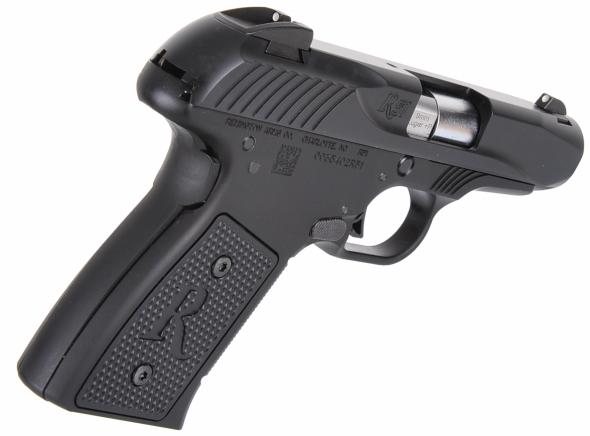
The trigger did not feel gummy or imprecise in pull. The break was clean, over travel wasn’t noticeable, but the pull was consistently heavy at a measured and verified 7 Lbs 3 Oz. The trigger does have some side movement… alright, a good deal of side movement, but I tend to pull triggers straight back rather than side to side, so the movement didn’t matter much. I don’t like the plastic trigger. I think it looks out of place on the pistol and, aesthetically, it does it a disservice. The pistol’s price increased from 2014 to 2016 by $28, which should have covered the cost of a decent trigger.
A note on Internet critics…
In 1965, Ralph Nader, a man with a liberal arts and law degree, published a one chapter technical condemnation of the popular Chevrolet Corvair in his book “Unsafe at Any Speed”. Using only manipulated statistical inference, the sensationalism of liberal press and the public’s never ending need for hysteria, the book forced GM to withdraw the Corvair from the market. Nader was lauded as a hero to consumerism. In 1971, two years after the Corvair was driven out of production, the National Highway Traffic Safety Administration conducted a competent technical evaluation of the product and the Corvair was completely exonerated. Unfortunately, scandal sells more newspapers than truth, so no one paid much attention to the acquittal.
The Corvair was a terrific little car; affordable and with good acceleration and cornering performance. America lost that product, the public lost millions in diminished GM stock value, tens of thousands of people lost their jobs. Nader remains a self serving lawyer who has no problem ruining a product and people for personal gain. Social media is even worse. Not only are unqualified people unfairly destroying the reputation of firearms and the people that make them, they are destroying segments of the firearm industry. It’s as though anyone who drives a car, thinks they are qualified to repair them, or worse, qualified to design them. I accept I am just a driver and leave the design analysis to others.
The R51 isn’t a 1911…
There are a least a dozen videos on YouTube showing an R51 in this state, with the narrator pulling the trigger and concluding that the R51 can be fired out of battery. That would be true… if the R51 was a 1911 type. A 1911 is a tilting barrel design where the barrel and slide are locked together at the
moment of firing. After firing, the barrel and slide recoil to the rear a short distance, until the barrel is cammed downward from the locked position, permitting the slide to continue on and cycle. That is not how the R51 design works.
The R51 has a fixed barrel and the recoil spring is wound about the barrel rather than a guide rod. Replacing the tilting barrel’s function is a locking breech block that fits within the slide. When fired, the slide and breech block are not locked in position. They travel rearward a short distance and then the breech block stops against a locking shoulder in the frame until chamber pressure drops to zero. At that point the slide cams the nose of the breech block downward, unlocking the breech block, and allowing the pistol to continue its cycle of ejection and chambering of the next round.
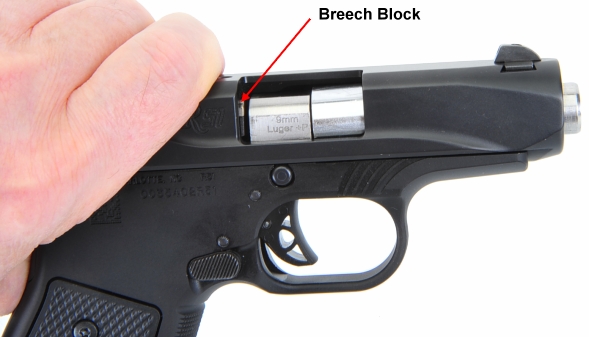
In the picture above, even though a bit of muzzle is exposed, the breech block is level and still locked so the trigger can be pulled. A few thousandths more rearward slide movement and the breech block would make contact to begin unlocking. At that point the trigger would disconnect and no longer function. This isn’t a defect, not a safety issue and it is of no consequence within this design. In fact, if you shine a light down into the chamber indicator port with the slide in battery, you will see that the breech block does not rest flush against the barrel and you can move the slide rearward and see through the ejection port how far rearward the slide travels before the breech block is unlocked.
Why the Pedersen design and why not design the R51 closer to existing firearms? Again, the design reduces parts count for increased reliability. It allows the bore centerline to be dropped relative to the frame, which reduces reciprocating mass and recoil. Recoil is further reduced by the increased locked (not lock) time and the strength of the action is easily suitable for 9mm +P Luger ammo. Picture of bulged fired case below… No, there is no picture because there were no symptoms of unsupported cases blowing out under pressure, not in hot handloads and not in +P factory ammo. But then I don’t put junk, non SAAMI or CIP approved ammo in my firearms.
I don’t know that it is, but I swear it is bad… Bad, bad, bad.
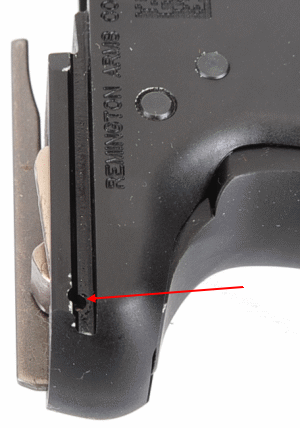
The arrow is pointing to an ejector pin access hole, not a location to hold a disconnector pin. The ejector pin is installed from the left side of the pistol and this through hole allows a punch to be inserted through the disconnector to drive out the ejector pin.
Unfortunately there are folks with video equipment, and little knowledge of the R51 design who have produced twenty minute long videos condemning Remington for inserting a short pin, erroneously thinking the ejector pivot pin has something to do with the disconnector.
The shame of it is, these folks clearly did not spend five minutes to look at the noted assemblies to understand how they work. They also didn’t pick up a phone to call Remington to confirm the function of the pin. No, they spent hours producing a video and placing it on YouTube because they wanted to say something negative about the product. Perhaps the same source should produce a video apologizing to Remington for the incorrect analysis? As Remington accepted their responsibility for early product problems, it would seem only fair.
Milling is not a single word that defines all machining operations…
Milling is an operation performed with a rotary cutter where the work piece moves along an axis in relationship to the cutter. Milling is not boring, grinding, reaming, or hammer forging. One of the videos I ran across, quite professionally produced, the narrator seemed to think that milling was synonymous with tool marks as he found them everywhere from the outer slide to the barrel’s chamber. I found the assembly to be cleanly machined, inside and out. I did find stamped parts, like the ejector, to be burr free, but very square edged.
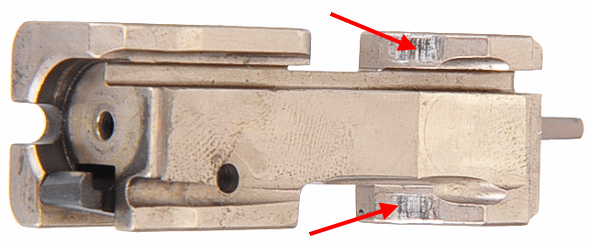
Excessive wear on frame rails or slide was not evident, however, the ramped contact surfaces on the breech block seemed to have taken a bit of a beating. Another couple hundred rounds are to be fired, then a critical inspection of these surfaces will be accomplished and researched to place them into proper context.
Remington 51 and Remington R51
The R51 has been framed as a tribute to the early 20th century Remington 51; a Pedersen design that was also a delayed blowback design. In fact, removing the slide from an early 51 is very similar to the process for the new version. With the slide removed, very similar recoil components are found, right down to the disassembly grooves at the muzzle end of the barrel. Both versions, in my opinion, are very good looking firearms but, more than aesthetics, there is a functional advantage to exploit.
As a defensive weapon, where the anticipation of more than one shot fired is realistic, the Remington R51 is designed to deliver follow up shots without struggling for control of the pistol and without stressing a shooting hand. The heft is good, the balance is good and, for me, all metal firearms just feel better than poly frame firearms. So I am not going to do a hatchet job on this pistol. That is not warranted. Instead I am going to clock some ammo, make a more focused effort and do some precise shooting and report back on those results.
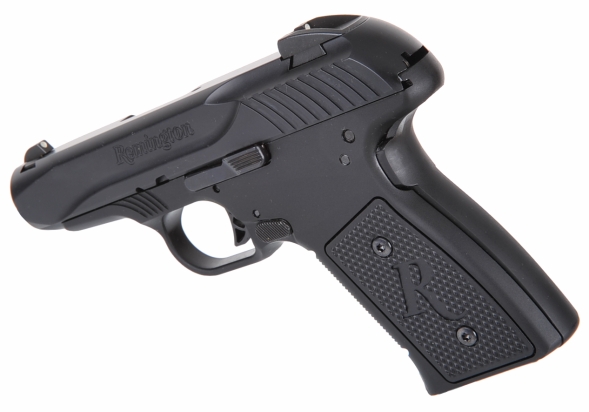
Remington’s Newly Released R51 9mm +P Part 1
Remington’s Newly Released R51 9mm +P Part 2

Email Notification